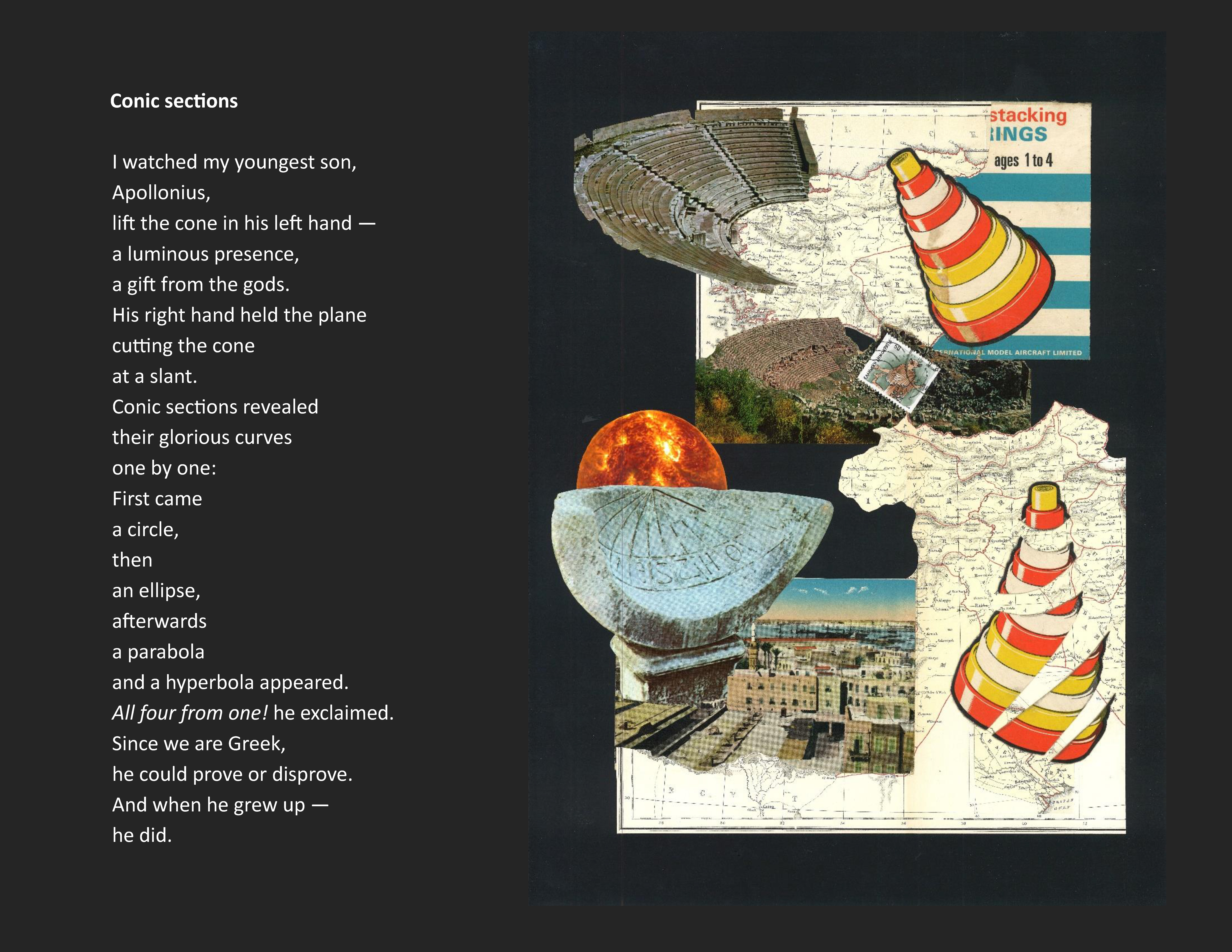A Poem-Collage Project
Poem by Sarah Glaz with Collage by Mark Sanders
The poem-collage pair appears in the Bridges 2024 online art gallery: https://gallery.bridgesmathart.org/exhibitions/bridges-2024-exhibition-of-mathematical-art/sarah-glaz-mark-sanders
 |
 |
History, Mathematics, Poem, Collage
Apollonius of Perga (262 -190 BCE) was a Greek
mathematician and astronomer known in his times as "The Great
Geometer." His treatise, Conics, expanded on the work
of the two other giants in his field, Euclid and Archimedes, and
brought the knowledge of conic sections -- ellipses, parabolas,
and hyperbolas -- to the state prior to the invention of the
Cartesian coordinate system in the 17th century.
Apollonius was born in Perga, a Greek city located in
Pamphylia (today Anatolia, Turkey). Perga is represented in the
collage's center by the ruins of its ancient amphitheater and
the postage stamp picturing the goddess Artemis, the main deity
worshiped in that city. Apollonius was named after the god
Apollo, twin brother of Artemis.
Most of the information we have about Apollonius' life
comes from the prefaces of the various books of his masterpiece,
Conics. Seven out of the eight books of Conics survived
either in the original Greek or in Arabic translations. Conics'
entire first draft was written in Alexandria, Egypt, where
Apollonius received his mathematics education from the followers
of Euclid at the Alexandrian Museum, and where he resided for
years after, lecturing on mathematics, writing his mathematical
treatises and raising a family. Apollonius revised the eight
books of Conics for most of his life, sending the final
versions as they were completed to various personages in
Pergamum. The city of Pergamum, situated in Myasia (today Izmir,
Turkey), was a major center of Hellenistic culture and learning.
It was home to a library and a Museum similar to the ones in
Alexandria, both flourishing under its royal patronage. The
first two books of Conics were sent to the
mathematician, Eudemus of Pergamum, who might have been
Apollonius' teacher prior to his moving to Alexandria. The last
several books of Conics were sent to King Attalus I of
Pergamum to be placed in Pergamum's library. It is not known how
long Apollonius stayed in Pergamum. Apollonius lived during the
Golden Age of Greek mathematics, when Greek mathematicians from
all the corners of the Hellenistic world kept in touch with each
other through frequent correspondence and mutual visits. He may
have become acquainted with Pergamum's nobility on one of his
visits. Still, sending his books to Pergamum's library rather
than Alexandria's library may mean that he moved from Alexandria
to Pergamum later in life. Pergamum is represented in the
collage by the ruins of its ancient amphitheater at the top
left, and Alexandria is featured in the image at the bottom
left.
Prior to Apollonius' work, geometers treated conic
sections as arising from three types of cones, differing from
each other by their vertex angle. One of the innovations
Apollonius introduced in Conics was unifying the method
of generating conic sections by using only one cone, of any
kind, and varying the inclination at which the intersecting
plane meets the cone's surface. Both the poem and the images of
the cones on the right-hand side of the collage reflect this
innovation. The colorful cone is a classic toddler's toy, called
Stacking Rings, where doughnut shaped objects need to be looped
on a central peg in appropriate order. Watching a child play
with this cone toy, we can imagine how a mathematical genius of
great magnitude shows its promise, which later will bloom into
achievements, very early in life.
The names we use for conic sections today: ellipse,
parabola, and hyperbola, were coined by Apollonius in Conics.
Most properties of conic sections, including their formulas,
were discovered by Apollonius and with the advent of the
coordinate system had only to be "translated" from the
cumbersome language of ancient Greek geometry into the modern
language of coordinate geometry to make them accessible.
Apollonius authored several other works, none of which survived,
except for a few fragments or mentions in treatises written by
his successors. In addition to several other landmark results in
geometry, Apollonius is credited with accomplishments in optics
and astronomy. He is considered one of the founders of
mathematical astronomy. Claudius Ptolemy attributed the theory
of epicycles to explain planetary motion to Apollonius. It is
also known that he developed an improved sundial, the
hemicyclium,
which having the hour lines drawn on the surface of a conic
section yielded greater accuracy. An image of a hemicyleum
sundial is included in the collage's left-hand side, with the
sun emerging from behind. It is worth noting that the
amphitheater structures above, mirror the shape of the
hemicylium. For more details see Mark's Dissecting
Apollonius.
Many thanks to Claudine
Burns Smith for help with formatting the
poem-collage pair to the Bridges 2024 Art Exhibit
specifications.
